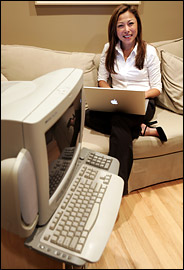SAN FRANCISCO, July 15 - Add personal computers to the list of throwaways in the disposable society.
On a recent Sunday morning when Lew Tucker's Dell desktop computer was overrun by spyware and adware - stealth software that delivers intrusive advertising messages and even gathers data from the user's machine - he did not simply get rid of the offending programs. He threw out the whole computer.

Terrelea Wong, a doctor who replaced her infected computer, says she no longer clicks on pop-ups.
Mr. Tucker, an Internet industry executive who holds a Ph.D. in computer science, decided that rather than take the time to remove the offending software, he would spend $400 on a new machine.
He is not alone in his surrender in the face of growing legions of digital pests, not only adware and spyware but computer viruses and other Internet-borne infections as well. Many PC owners are simply replacing embattled machines rather than fixing them.
"I was spending time every week trying to keep the machine free of viruses and worms," said Mr. Tucker, a vice president of Salesforce.com, a Web services firm based here. "I was losing the battle. It was cheaper and faster to go to the store and buy a low-end PC."
In the face of a constant stream of pop-up ads, malfunctioning programs and performance slowed to a crawl or a crash - the hallmarks of spyware and adware - throwing out a computer "is a rational response," said Lee Rainie, director of the Pew Internet and American Life Project, a Washington-based research group that studies the Internet's social impact.
While no figures are available on the ranks of those jettisoning their PC's, the scourge of unwanted software is widely felt. This month the Pew group published a study in which 43 percent of the 2,001 adult Internet users polled said they had been confronted with spyware or adware, collectively known as malware. Forty-eight percent said they had stopped visiting Web sites that might deposit unwanted programs on their PC's.
Moreover, 68 percent said they had had computer trouble in the last year consistent with the problems caused by spyware or adware, though 60 percent of those were unsure of the problems' origins. Twenty percent of those who tried to fix the problem said it had not been solved; among those who spent money seeking a remedy, the average outlay was $129.
By comparison, it is possible to buy a new computer, including a monitor, for less than $500, though more powerful systems can cost considerably more.
Meantime, the threats from infection continue to rise, and "the arms race seems to have tilted toward the bad guys," Mr. Rainie said.
The number of viruses has more than doubled in just the last six months, while the number of adware and spyware programs has roughly quadrupled during the same period, said Vincent Weafer, a senior director at Symantec, which makes the Norton computer security programs. One reason for the explosion, Symantec executives say, is the growth of high-speed Internet access, which allows people to stay connected to the Internet constantly but creates more opportunity for malicious programs to find their way onto machines.
Mr. Weafer said an area of particular concern was infections adept at burying themselves in a computer system so that the cleansing programs had trouble finding them. The removal of these programs must often be done manually, requiring greater technical expertise.
There are methods of protecting computers from infection through antivirus and spyware-removal software and digital barriers called firewalls, but those tools are far from being completely effective.
"Things are spinning out of control," said David Gelernter, a professor of computer science at Yale.
Mr. Gelernter said his own family's computer became so badly infected that he bought a new one this week. He said his two teenage sons were balking at spending the hours needed to scrub the old one clean of viruses, worms and adware.
Mr. Gelernter blames the software industry for the morass, noting that people are increasingly unwilling to take out their "software tweezers" to clean their machines.
Microsoft executives say they decided to enter the anti-spyware business earlier this year after realizing the extent of the problem.










